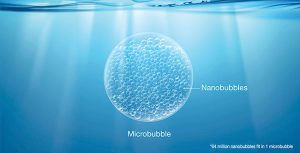Nanobubbles:

The Union Minister of State for Forest, Environment, and Climate Change recently launched ‘Nano Bubble Technology’ for cleaning and purifying the water of the National Zoological Park, Delhi, to promote the health of aquatic animals.
- These are 70-120 nanometers in size, 2500 times smaller than a single grain of salt.
- They can be formed using any gas and injected into any liquid.
- They have unique physical and chemical properties and are superior to other aeration methods.
- Therefore, nanobubble technology is used in a variety of applications, including water treatment, agriculture, aquaculture, food processing, and other industrial areas.
- Large Surface Area: Nanobubbles have a high surface area to volume ratio, allowing for a greater amount of gas to be in contact with water. This, combined with their ability to remain suspended in water due to their small size and high buoyancy, results in increased gas transfer efficiency between the gas and water phases.
- Nanobubbles stay in the water for a long time.
- This unique feature enables nanobubbles to provide a homogenous distribution of oxygen throughout an entire body of water and dissolved oxygen levels are maintained for a very long time.
- Nanobubbles can efficiently deliver oxygen into water due to the very large surface area and their Brownian motion. Oxygen transfer efficiency with nanobubbles is reached to around 90%.
- Nanobubbles have a strong negative surface charge. This negative charge improves separation efficiency in the floating process.
- Due to the various inherent physical properties of nanobubbles, the ability to transfer gas to liquid is very high, and thus has the following advantages:
- Nanobubbles can effectively remove organic pollutants, bacteria, and other contaminants from water.
- Nanobubbles can penetrate surface pores and crevices, providing a more thorough cleaning that is effective against stubborn dirt and grime.
- Supplying oxygen nanobubbles to plants and aquatic organisms can improve their growth, health, and resilience.
- Nanobubbles can also enhance nutrient absorption, reduce the need for pesticides and other chemicals, and improve crop yields.
- Nanobubbles can increase the efficiency of oil and gas recovery by improving the flow of fluids and reducing the amount of chemicals needed in the process.
- Nanobubbles can help enhance the absorption of skincare products, leading to healthier skin.




